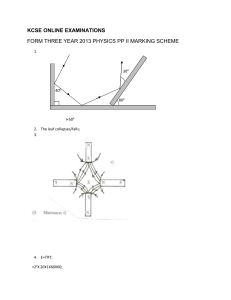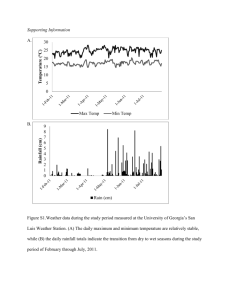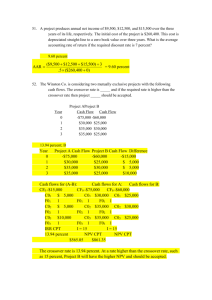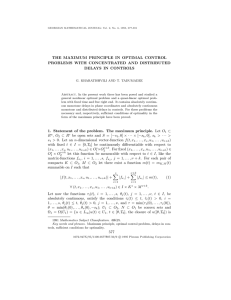Document 10454037
advertisement
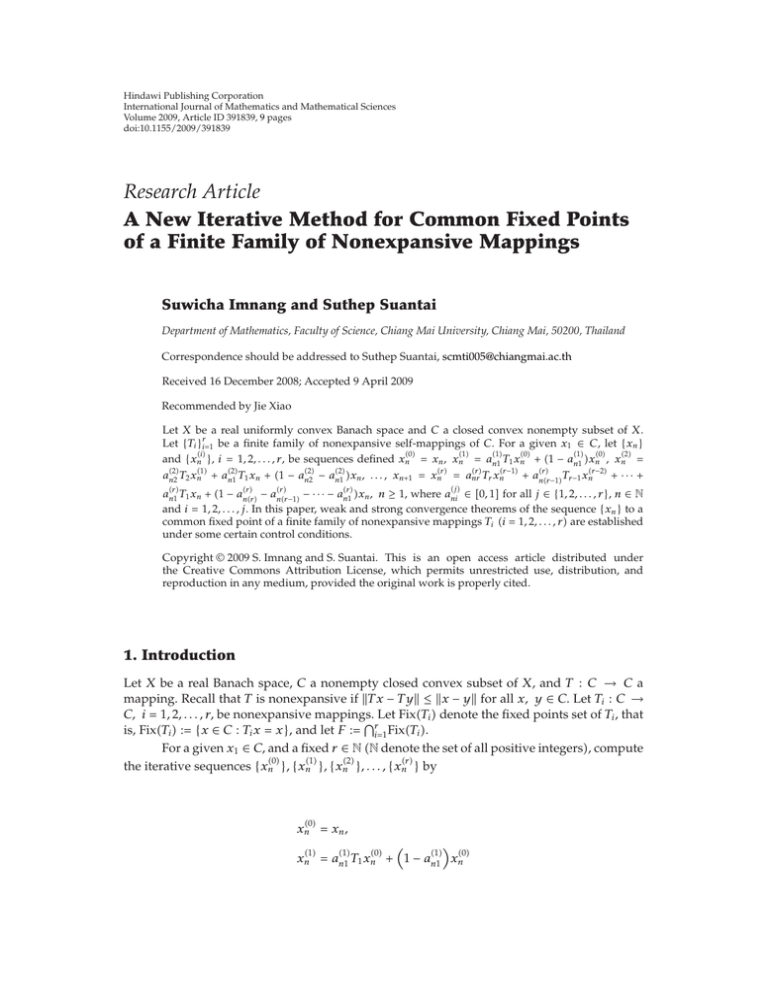
Hindawi Publishing Corporation
International Journal of Mathematics and Mathematical Sciences
Volume 2009, Article ID 391839, 9 pages
doi:10.1155/2009/391839
Research Article
A New Iterative Method for Common Fixed Points
of a Finite Family of Nonexpansive Mappings
Suwicha Imnang and Suthep Suantai
Department of Mathematics, Faculty of Science, Chiang Mai University, Chiang Mai, 50200, Thailand
Correspondence should be addressed to Suthep Suantai, scmti005@chiangmai.ac.th
Received 16 December 2008; Accepted 9 April 2009
Recommended by Jie Xiao
Let X be a real uniformly convex Banach space and C a closed convex nonempty subset of X.
Let {Ti }ri1 be a finite family of nonexpansive self-mappings of C. For a given x1 ∈ C, let {xn }
i
0
1
1
0
1
0
2
and {xn }, i 1, 2, . . . , r, be sequences defined xn xn , xn an1 T1 xn 1 − an1 xn , xn 2
1
2
2
2
r
an2 T2 xn an1 T1 xn 1 − an2 − an1 xn , . . . , xn1 xn
r
an1 T1 xn
r
anr
r
anr−1
r
an1 xn ,
r
r−1
anr Tr xn
j
ani
r
r−2
anr−1 Tr−1 xn
··· 1 −
−
− ··· −
n ≥ 1, where
∈ 0, 1 for all j ∈ {1, 2, . . . , r}, n ∈ N
and i 1, 2, . . . , j. In this paper, weak and strong convergence theorems of the sequence {xn } to a
common fixed point of a finite family of nonexpansive mappings Ti i 1, 2, . . . , r are established
under some certain control conditions.
Copyright q 2009 S. Imnang and S. Suantai. This is an open access article distributed under
the Creative Commons Attribution License, which permits unrestricted use, distribution, and
reproduction in any medium, provided the original work is properly cited.
1. Introduction
Let X be a real Banach space, C a nonempty closed convex subset of X, and T : C → C a
mapping. Recall that T is nonexpansive if T x − T y ≤ x − y for all x, y ∈ C. Let Ti : C →
C, i 1, 2, . . . , r, be nonexpansive mappings. Let FixTi denote the fixed points set of Ti , that
is, FixTi : {x ∈ C : Ti x x}, and let F : ri1 FixTi .
For a given x1 ∈ C, and a fixed r ∈ N N denote the set of all positive integers, compute
0
1
2
r
the iterative sequences {xn }, {xn }, {xn }, . . . , {xn } by
0
xn xn ,
1
1
0
1
0
xn an1 T1 xn 1 − an1 xn
2
International Journal of Mathematics and Mathematical Sciences
2
2
1
2
2
2
xn an2 T2 xn an1 T1 xn 1 − an2 − an1 xn ,
..
.
r
r
r−1
r
r−2
r
anr−1 Tr−1 xn
· · · an1 T1 xn
xn1 xn anr Tr xn
r
r
r
1 − anr − anr−1 − · · · − an1 xn , n ≥ 1,
1.1
j
j
where ani ∈ 0, 1 for all j ∈ {1, 2, . . . , r}, n ∈ N and i 1, 2, . . . , j. If ani : 0, for all n ∈ N,
j ∈ {1, 2, . . . , r − 1} and i 1, 2, . . . , j, then 1.1 reduces to the iterative scheme
xn1 Sn xn ,
r
r
r
n ≥ 1,
r
1.2
r
r
r
where Sn : anr Tr anr−1 Tr−1 · · · an1 T1 1 − anr − anr−1 − · · · − an1 I, ani ∈ 0, 1 for all
i 1, 2, . . . , r and n ∈ N.
j
r
If ani : 0, for all n ∈ N, j ∈ {1, 2, . . . , r − 1}, i 1, 2, . . . , j and ani : αi , for all n ∈ N for
all i 1, 2, . . . , r, then 1.1 reduces to the iterative scheme defined by Liu et al. 1
xn1 Sxn ,
n ≥ 1,
1.3
where S : αr Tr αr−1 Tr−1 · · · α1 T1 1 − αr − αr−1 − · · · − α1 I, αi ≥ 0 for all i 2, 3, . . . , r
and 1 − αr − αr−1 − · · · − α1 > 0. They showed that {xn } defined by 1.3 converges strongly to
a common fixed point of Ti , i 1, 2, . . . , r, in Banach spaces, provided that Ti , i 1, 2, . . . , r
satisfy condition A. The result improves the corresponding results of Kirk 2, Maiti and Saha
3 and Sentor and Dotson 4.
2
If r 2 and an1 : 0 for all n ∈ N, then 1.1 reduces to a generalization of Mann and
Ishikawa iteration given by Das and Debata 5 and Takahashi and Tamura 6. This scheme
dealts with two mappings:
1
1
1
xn an1 T1 xn 1 − an1 xn ,
2
2
1
2
xn1 xn an2 T2 xn 1 − an2 xn ,
1
2
1.4
n ≥ 1,
where {an1 }, {an2 } are appropriate sequences in 0, 1.
The purpose of this paper is to establish strong convergence theorems in a uniformly
convex Banach space of the iterative sequence {xn } defined by 1.1 to a common fixed
point of Ti i 1, 2, . . . , r under some appropriate control conditions in the case that one
of Ti i 1, 2, . . . , r is completely continuous or semicompact or {Ti }ri1 satisfies condition
B. Moreover, weak convergence theorem of the iterative scheme 1.1 to a common fixed
point of Ti i 1, 2, . . . , r is also established in a uniformly convex Banach spaces having the
Opial’s condition.
International Journal of Mathematics and Mathematical Sciences
3
2. Preliminaries
In this section, we recall the well-known results and give a useful lemma that will be used in
the next section.
Recall that a Banach space X is said to satisfy Opial’s condition 7 if xn → x weakly
as n → ∞ and x /
y imply that lim supn → ∞ xn − x < lim supn → ∞ xn − y. A finite family
∅ is said to satisfy condition
of mappings Ti : C → C i 1, 2, . . . , r with F : ri1 FixTi /
(B) 8 if there is a nondecreasing function f : 0, ∞ → 0, ∞ with f0 0 and ft > 0
for all t ∈ 0, ∞ such that max1≤i≤r {x − Ti x} ≥ fdx, F for all x ∈ C, where dx, F inf{x − p : p ∈ F}.
Lemma 2.1 see 9, Theorem 2. Let p > 1, r > 0 be two fixed numbers. Then a Banach space X
is uniformly convex if and only if there exists a continuous, strictly increasing, and convex function
g : 0, ∞ → 0, ∞, g0 0 such that
λx 1 − λyp ≤ λxp 1 − λyp − wp λg x − y ,
2.1
for all x, y in Br {x ∈ X : x ≤ r}, λ ∈ 0, 1, where
wp λ λ1 − λp λp 1 − λ.
2.2
Lemma 2.2 see 10, Lemma 1.6. Let X be a uniformly convex Banach space, C a nonempty closed
convex subset of X, and T : C → C nonexpansive mapping. Then I − T is demiclosed at 0, that is, if
xn → x weakly and xn − T xn → 0 strongly, then x ∈ FixT .
Lemma 2.3 see 11, Lemma 2.7. Let X be a Banach space which satisfies Opial’s condition and
let {xn } be a sequence in X. Let u, v ∈ X be such that limn → ∞ xn − u and limn → ∞ xn − v exist.
If {xnk } and {xmk } are subsequences of {xn } which converge weakly to u and v, respectively, then
u v.
Lemma 2.4. Let X be a uniformly convex Banach space and Br {x ∈ X : x ≤ r}, r > 0. Then
for each n ∈ N, there exists a continuous, strictly increasing, and convex function g : 0, ∞ →
0, ∞, g0 0 such that
2
n
n
αi xi 2 − α1 α2 gx1 − x2 ,
αi xi ≤
i1
i1
for all xi ∈ Br and all αi ∈ 0, 1 i 1, 2, . . . , n with
n
i1 αi
2.3
1.
Proof. Clearly 2.3 holds for n 1, 2, by Lemma 2.1. Next, suppose that 2.3 is true when n k − 1. Let xi ∈ Br and αi ∈ 0, 1, i 1, 2, . . . , k with ki1 αi 1. Then αk−1 /1 − k−2
i1 αi xk−1 k−2
αk /1 − i1 αi xk ∈ Br . By Lemma 2.1, we obtain that
2
αk−1
αk
αk−1
αk
2
2
x
x
≤
k−1
k
k−2 xk−1 k−2 xk .
k−2
1 − k−2 αi
1
−
α
1
−
α
1
−
α
i1
i1 i
i1 i
i1 i
2.4
4
International Journal of Mathematics and Mathematical Sciences
By the inductive hypothesis, there exists a continuous, strictly increasing and convex function
g : 0, ∞ → 0, ∞, g0 0 such that
2
k−1
k−1 2
βi yi − β1 β2 g y1 − y2 βi yi ≤
i1
i1
for all yi ∈ Br and all βi ∈ 0, 1, i 1, 2, . . . , k − 1 with
k−1
i1
2.5
βi 1. It follows that
2 2
k
k−2
k−2
αk−1 xk−1
αk xk
αi xi αi xi 1 − αi
k−2
k−2
i1
i1
1 − i1 αi 1 − i1 αi i1
2
k−2
k−2
α x
x
α
k−1
k−1
k
k
≤
αi xi 2 1 − αi − α1 α2 gx1 − x2 k−2
k−2 1−
αi 1 −
αi
i1
i1
≤
k−2
2
αi xi i1
k
1−
k−2
αi
i1
i1
i1
2
αk−1 xk−1 αk xk 2
1 − k−2
1 − k−2
i1 αi
i1 αi
− α1 α2 gx1 − x2 αi xi 2 − α1 α2 gx1 − x2 .
i1
2.6
Hence, we have the lemma.
3. Main Results
In this section, we prove weak and strong convergence theorems of the iterative scheme 1.1
for a finite family of nonexpansive mappings in a uniformly convex Banach space. In order
to prove our main results, the following lemmas are needed.
The next lemma is crucial for proving the main theorems.
Lemma 3.1. Let X be a Banach space and C a nonempty closed and convex subset of X. Let {Ti }ri1
j
be a finite family of nonexpansive self-mappings of C. Let ani ∈ 0, 1 for all j ∈ {1, 2, . . . , r}, n ∈ N
∅, then
and i 1, 2, . . . , j. For a given x1 ∈ C, let the sequence {xn } be defined by 1.1. If F /
xn1 − p ≤ xn − p for all n ∈ N and limn → ∞ xn − p exists for all p ∈ F.
Proof. Let p ∈ F. For each n ≥ 1, we note that
1
1
1
xn − p an1 T1 xn 1 − an1 xn − p
1 1 ≤ an1 T1 xn − p 1 − an1 xn − p
≤
1 an1 xn
1 xn − p
− p 1 − a
xn − p.
n1
3.1
International Journal of Mathematics and Mathematical Sciences
5
It follows from 3.1 that
2
2
1
2
2
2
xn − p an2 T2 xn an1 T1 xn 1 − an2 − an1 xn − p
2 1
2 2
2 ≤ an2 T2 xn − p an1 T1 xn − p 1 − an2 − an1 xn − p
≤
2 1
an2 xn
2 2
2 − p an1 xn − p 1 − an2 − an1 xn − p
3.2
≤ xn − p.
By 3.1 and 3.2, we have
3
3
2
3
1
3
3
3
3
xn − p an3 T3 xn an2 T2 xn an1 T1 xn 1 − an3 − an2 − an1 xn − p
3 2
3 1
3 ≤ an3 T3 xn − p an2 T2 xn − p an1 T1 xn − p
3
3
3 1 − an3 − an2 − an1 xn − p
3 2
3 1
3 ≤ an3 xn − p an2 xn − p an1 xn − p
3.3
3
3
3 1 − an3 − an2 − an1 xn − p
≤ xn − p.
By continuing the above argument, we obtain that
i
xn − p ≤ xn − p ∀i 1, 2, . . . , r.
3.4
In particular, we get xn1 − p ≤ xn − p for all n ∈ N, which implies that limn → ∞ xn − p
exists.
Lemma 3.2. Let X be a uniformly convex Banach space and C a nonempty closed and convex subset of
j
∅ and ani ∈ 0, 1 for all
X. Let {Ti }ri1 be a finite family of nonexpansive self-mappings of C with F /
j j
j ∈ {1, 2, . . . , r}, n ∈ N and i 1, 2, . . . , j such that i1 ani are in 0, 1 for all j ∈ {1, 2, . . . , r} and
r
r
n ∈ N. For a given x1 ∈ C, let {xn } be defined by 1.1. If 0 < lim infn → ∞ ani ≤ lim supn → ∞ anr r
r
anr−1 · · · an1 < 1, then
i−1
i limn → ∞ Ti xn
− xn 0 for all i 1, 2, . . . , r,
ii limn → ∞ Ti xn − xn 0 for all i 1, 2, . . . , r,
i
iii limn → ∞ xn − xn 0 for all i 1, 2, . . . , r.
Proof. i Let p ∈ F, by Lemma 3.1, supn xn − p < ∞. Choose a number s > 0 such that
i
i−1
supn xn − p < s, it follows by 3.4 that {xn − p}, {Ti xn − p} ⊆ Bs , for all i ∈ {1, 2, . . . , r}.
6
International Journal of Mathematics and Mathematical Sciences
By Lemma 2.4, there exists a continuous strictly increasing convex function g :
0, ∞ → 0, ∞, g0 0 such that
2
n
n
αi xi 2 − α1 α2 gx1 − x2 ,
αi xi ≤
i1
i1
for all xi ∈ Bs , αi ∈ 0, 1 i 1, 2, . . . , n with
i 1, 2, . . . , r,
n
i1 αi
3.5
1. By 3.4 and 3.5, we have for
r
r−1
r
r−2
r
xn1 − p2 anr−1 Tr−1 xn
· · · an1 T1 xn
anr Tr xn
2
r
r
r
1 − anr − anr−1 − · · · − an1 xn − p
2
2
r r−1
r
r−2
≤ anr Tr xn
− p anr−1 Tr−1 xn
− p · · ·
2 2
r r
r
r an1 T1 xn − p 1 − anr − anr−1 − · · · − an1 xn − p
i−1
r
r
r
r
− ani 1 − anr − anr−1 − · · · − an1 g Ti xn − xn 2
2
2
r−2
r r−1
r
r ≤ anr xn
− p anr−1 xn
− p · · · an1 xn − p
1−
r
anr
−
r
anr−1
− ··· −
r
an1
3.6
xn − p2
i−1
r
r
r
r
− ani 1 − anr − anr−1 − · · · − an1 g Ti xn − xn 2
2
2
r r
r ≤ anr xn − p anr−1 xn − p · · · an1 xn − p
2
r
r
r 1 − anr − anr−1 − · · · − an1 xn − p
i−1
r
r
r
r
− ani 1 − anr − anr−1 − · · · − an1 g Ti xn − xn 2
i−1
r
r
r
r
xn − p − ani 1 − anr − anr−1 − · · · − an1 g Ti xn − xn .
Therefore
2 2
i−1
r
r
r
r
ani 1 − anr − anr−1 − · · · − an1 g Ti xn − xn ≤ xn − p − xn1 − p
r
r
r
3.7
r
for all i 1, 2, . . . , r. Since 0 < lim infn → ∞ ani ≤ lim supn → ∞ anr anr−1 · · · an1 < 1,
i−1
it implies by Lemma 3.1 that limn → ∞ gTi xn − xn 0. Since g is strictly increasing and
i−1
continuous at 0 with g0 0, it follows that limn → ∞ Ti xn − xn 0 for all i 1, 2, . . . , r.
International Journal of Mathematics and Mathematical Sciences
7
ii For i ∈ {1, 2, . . . , r}, we have
i−1 i−1
Ti xn − xn ≤ Ti xn − Ti xn Ti xn − xn i−1
i−1 ≤ xn − xn Ti xn − xn ≤
3.8
i−1
j−1
i−1
i−1 anj Tj xn − xn Ti xn − xn .
j1
It follows from i that
Ti xn − xn −→ 0 as
n −→ ∞.
3.9
iii For i ∈ {1, 2, . . . , r}, it follows from i that
i
j−1
i
i anj Tj xn − xn −→ 0 as
xn − xn ≤
n −→ ∞.
3.10
j1
Theorem 3.3. Let X be a uniformly convex Banach space and C a nonempty closed and convex subset
of X. Let {Ti }ri1 be a finite family of nonexpansive self-mappings of C with F /
∅. Let the sequence
j ∞
i
{ani }n1 be as in Lemma 3.2. For a given x1 ∈ C, let sequences {xn } and {xn } i 0, 1, . . . , r be
j
defined by 1.1. If one of {Ti }ri1 is completely continuous then {xn } and {xn } converge strongly to
a common fixed point of {Ti }ri1 for all j 1, 2, . . . , r.
Proof. Suppose that Ti0 is completely continuous where i0 ∈ {1, 2, . . . , r}. Then there exists a
subsequence {xnk } of {xn } such that {Ti0 xnk } converges.
Let limk → ∞ Ti0 xnk q for some q ∈ C. By Lemma 3.2 ii, limn → ∞ Ti0 xn − xn 0. It
follows that limk → ∞ xnk q. Again by Lemma 3.2ii, we have limn → ∞ Ti xn − xn 0 for
all i 1, 2, . . . , r. It implies that limk → ∞ Ti xnk q. By continuity of Ti , we get Ti q q, i 1, 2, . . . , r. So q ∈ F. By Lemma 3.1, limn → ∞ xn − q exists, it follows that limn → ∞ xn − q 0.
j
By Lemma 3.2iii, we have limn → ∞ xn − xn 0 for each j ∈ {1, 2, . . . , r}. It follows that
j
limn → ∞ xn q for all j 1, 2, . . . , r.
Theorem 3.4. Let X be a uniformly convex Banach space and C a nonempty closed and convex subset
of X. Let {Ti }ri1 be a finite family of nonexpansive self-mappings of C with F / ∅. Let the sequence
j ∞
i
{ani }n1 be as in Lemma 3.2. For a given x1 ∈ C, let sequences {xn } and {xn } i 0, 1, . . . , r be
j
defined by 1.1. If the family {Ti }ri1 satisfies condition (B) then {xn } and {xn } converge strongly to
a common fixed point of {Ti }ri1 for all j 1, 2, . . . , r.
Proof. Let p ∈ F. Then by Lemma 3.1, limn → ∞ xn − p exists and xn1 − p ≤ xn − p for all
n ≥ 1. This implies that dxn1 , F ≤ dxn , F for all n ≥ 1, therefore, we get limn → ∞ dxn , F
exists. By Lemma 3.2ii, we have limn → ∞ Ti xn − xn 0 for each i 1, 2, . . . , r. It follows,
by the condition B that limn → ∞ fdxn , F 0. Since f is nondecreasing and f0 0,
therefore, we get limn → ∞ dxn , F 0. Next we show that {xn } is a Cauchy sequence. Since
8
International Journal of Mathematics and Mathematical Sciences
limn → ∞ dxn , F 0, given any > 0, there exists a natural number n0 such that dxn , F < /2
for all n ≥ n0 . In particular, dxn0 , F < /2. Then there exists q ∈ F such that xn0 − q < /2.
For all n ≥ n0 and m ≥ 1, it follows by Lemma 3.1 that
xnm − xn ≤ xnm − q xn − q ≤ xn0 − q xn0 − q < .
3.11
This shows that {xn } is a Cauchy sequence in C, hence it must converge to a point of C.
Let limn → ∞ xn p∗ . Since limn → ∞ dxn , F 0 and F is closed, we obtain p∗ ∈ F. By
j
j
Lemma 3.2iii, limn → ∞ xn − xn 0 for each j ∈ {1, 2, . . . , r}. It follows that limn → ∞ xn p∗
for all j 1, 2, . . . , r.
j
In Theorem 3.4, if ani : 0, for all n ∈ N, j ∈ {1, 2, . . . , r − 1} and i 1, 2, . . . , j, we obtain
the following result.
Corollary 3.5. Let X be a uniformly convex Banach space and C a nonempty closed and convex
r
∅ and ani ∈
subset of X. Let {Ti }ri1 be a finite family of nonexpansive self-mappings of C with F /
r r
0, 1 for all i 1, 2, . . . , r and n ∈ N such that i1 ani are in 0, 1 for all n ∈ N. For a given
x1 ∈ C, let the sequence {xn } be defined by 1.2. If the family {Ti }ri1 satisfies condition (B) and
r
r
r
r
0 < lim infn → ∞ ani ≤ lim supn → ∞ anr anr−1 · · · an1 < 1, then the sequence {xn } converges
strongly to a common fixed point of {Ti }ri1 .
r
Remark 3.6. In Corollary 3.5, if ani αi , for all n ∈ N and for all i 1, 2, . . . , r, the iterative
scheme 1.2 reduces to the iterative scheme 1.3 defined by Liu et al. 1 and we obtain
strong convergence of the sequence {xn } defined by Liu et al. when {Ti }ri1 satisfies condition
B which is different from the condition A defined by Liu et al. and we note that the result
of Senter and Dotson 4 is a special case of Theorem 3.4 when r 1.
In the next result, we prove weak convergence for the iterative scheme 1.1 for a finite
family of nonexpansive mappings in a uniformly convex Banach space satisfying Opial’s
condition.
Theorem 3.7. Let X be a uniformly convex Banach space which satisfies Opial’s condition and C a
nonempty closed and convex subset of X. Let {Ti }ri1 be a finite family of nonexpansive self-mappings
j ∞
of C with F / ∅. For a given x1 ∈ C, let {xn } be the sequence defined by 1.1. If the sequence {ani }n1
r
is as in Lemma 3.2, then the sequence {xn } converges weakly to a common fixed point of {Ti }i1 .
Proof. By Lemma 3.2ii, limn → ∞ Ti xn − xn 0 for all i 1, 2, . . . , r. Since X is uniformly
convex and {xn } is bounded, without loss of generality we may assume that xn → u weakly
as n → ∞ for some u ∈ C. By Lemma 2.2, we have u ∈ F. Suppose that there are subsequences
{xnk } and {xmk } of {xn } that converge weakly to u and v, respectively. From Lemma 2.2,
we have u, v ∈ F. By Lemma 3.1, limn → ∞ xn − u and limn → ∞ xn − v exist. It follows
from Lemma 2.3 that u v. Therefore {xn } converges weakly to a common fixed point of
{Ti }ri1 .
j
For ani : 0, for all n ∈ N, j ∈ {1, 2, . . . , r − 1} and i 1, 2, . . . , j in Theorem 3.7, we
obtain the following result.
International Journal of Mathematics and Mathematical Sciences
9
Corollary 3.8. Let X be a uniformly convex Banach space which satisfies Opial’s condition and C a
nonempty closed and convex subset of X. Let {Ti }ri1 be a finite family of nonexpansive self-mappings
r
r
of C with F /
∅ and ani ∈ 0, 1 for all i 1, 2, . . . , r and n ∈ N such that ri1 ani are in 0, 1 for
r
all n ∈ N. For a given x1 ∈ C, let {xn } be the sequence defined by 1.2. If 0 < lim infn → ∞ ani ≤
r
r
r
lim supn → ∞ anr anr−1 · · · an1 < 1, then the sequence {xn } converges weakly to a common
r
fixed point of {Ti }i1 .
r
Remark 3.9. In Corollary 3.8, if ani αi , for all n ∈ N and for all i 1, 2, . . . , r, then we obtain
weak convergence of the sequence {xn } defined by Liu et al. 1.
Acknowledgments
The authors would like to thank the Commission on Higher Education, the Thailand Research
Fund, the Thaksin University, and the Graduate School of Chiang Mai University, Thailand
for their financial support.
References
1 G. Liu, D. Lei, and S. Li, “Approximating fixed points of nonexpansive mappings,” International
Journal of Mathematics and Mathematical Sciences, vol. 24, no. 3, pp. 173–177, 2000.
2 W. A. Kirk, “On successive approximations for nonexpansive mappings in Banach spaces,” Glasgow
Mathematical Journal, vol. 12, no. 1, pp. 6–9, 1971.
3 M. Maiti and B. Saha, “Approximating fixed points of nonexpansive and generalized nonexpansive
mappings,” International Journal of Mathematics and Mathematical Sciences, vol. 16, no. 1, pp. 81–86,
1993.
4 H. F. Senter and W. G. Dotson Jr., “Approximating fixed points of nonexpansive mappings,”
Proceedings of the American Mathematical Society, vol. 44, no. 2, pp. 375–380, 1974.
5 G. Das and J. P. Debata, “Fixed points of quasinonexpansive mappings,” Indian Journal of Pure and
Applied Mathematics, vol. 17, no. 11, pp. 1263–1269, 1986.
6 W. Takahashi and T. Tamura, “Convergence theorems for a pair of nonexpansive mappings,” Journal
of Convex Analysis, vol. 5, no. 1, pp. 45–56, 1998.
7 Z. Opial, “Weak convergence of the sequence of successive approximations for nonexpansive
mappings,” Bulletin of the American Mathematical Society, vol. 73, no. 4, pp. 591–597, 1967.
8 C. E. Chidume and N. Shahzad, “Strong convergence of an implicit iteration process for a finite family
of nonexpansive mappings,” Nonlinear Analysis, vol. 62, no. 6A, pp. 1149–1156, 2005.
9 H. K. Xu, “Inequalities in Banach spaces with applications,” Nonlinear Analysis: Theory, Methods &
Applications, vol. 16, no. 12, pp. 1127–1138, 1991.
10 Y. J. Cho, H. Zhou, and G. Guo, “Weak and strong convergence theorems for three-step iterations
with errors for asymptotically nonexpansive mappings,” Computers & Mathematics with Applications,
vol. 47, no. 4-5, pp. 707–717, 2004.
11 S. Suantai, “Weak and strong convergence criteria of Noor iterations for asymptotically nonexpansive
mappings,” Journal of Mathematical Analysis and Applications, vol. 311, no. 2, pp. 506–517, 2005.

